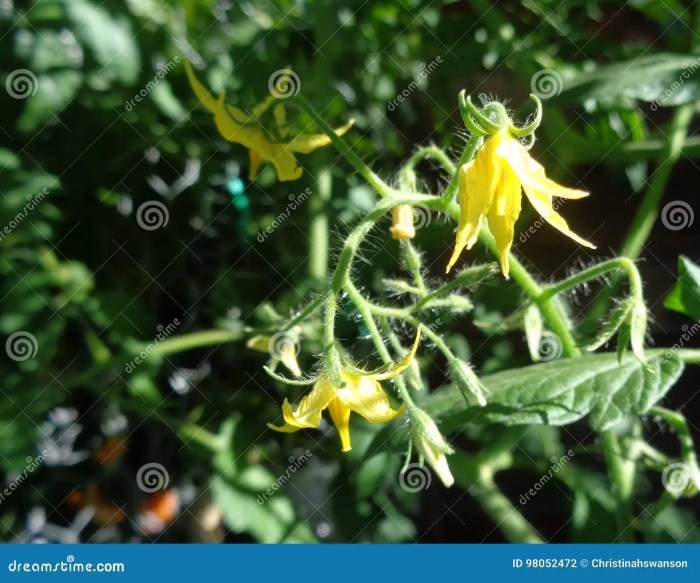Pollination of Tomato Flowers

Flowers of tomato plant – Tomato flowers, the precursors to the juicy fruits we enjoy, rely on a fascinating process of pollination for successful fruit set. This process, the transfer of pollen from the anther (male part) to the stigma (female part) of the flower, can occur through various mechanisms, ensuring the plant’s reproductive success.
Tomato plants are predominantly self-pollinating, meaning that pollen from a flower’s own anthers readily fertilizes its own stigma. This self-pollination is facilitated by the flower’s structure; the anthers are positioned close to the stigma, and often, pollen is released directly onto the stigma even without external assistance. This inherent ability to self-pollinate makes tomatoes relatively reliable producers, even in the absence of significant pollinator activity.
However, cross-pollination, the transfer of pollen between different tomato plants, also occurs and can introduce genetic diversity, leading to potentially more robust and productive plants.
The Process of Self-Pollination in Tomatoes, Flowers of tomato plant
Self-pollination in tomatoes is primarily a passive process. The flower’s structure, with the anthers surrounding the stigma, promotes the natural transfer of pollen. Gentle vibrations from wind or the plant’s own movements can aid in this process, causing pollen grains to fall onto the receptive stigma. The pollen then germinates, growing a pollen tube down to the ovary where fertilization takes place, ultimately leading to fruit development.
Tomato plant flowers, essential for fruit production, exhibit diverse responses to environmental stimuli. Understanding these responses can inform cultivation practices. Conversely, issues such as premature flower drop, a common problem also seen in orchids as detailed in this article on orchid plant losing flowers , highlight the importance of optimal growing conditions. Similarly, stress factors affecting tomato flower development may mirror those affecting orchids, impacting overall yield and blossom longevity.
The Role of Insects and Other Pollinators in Tomato Pollination
While self-pollination is the primary method for tomato plants, insects and other pollinators play a significant, albeit often underestimated, role in enhancing fruit set and potentially improving fruit quality. Bees, particularly bumblebees, are known to visit tomato flowers, and their activity can increase the amount of cross-pollination. As they move between flowers, they inadvertently transfer pollen, introducing genetic variation into the offspring.
This cross-pollination can lead to greater yield and disease resistance in the next generation.
Comparison of Pollination Methods and Effectiveness
The effectiveness of different pollination methods varies depending on environmental conditions and the specific cultivar of tomato plant. While self-pollination ensures a baseline level of fruit production, cross-pollination, often facilitated by pollinators, can enhance yield and overall plant health. The following table summarizes the different methods and their relative effectiveness:
| Pollination Method | Effectiveness | Advantages | Disadvantages |
|---|---|---|---|
| Self-pollination | High (reliable fruit set) | Reliable, requires no external factors | Limited genetic diversity, potential for inbreeding depression |
| Cross-pollination (insect-mediated) | Moderate to High (enhanced fruit set and quality) | Increased genetic diversity, potential for improved yield and disease resistance | Dependent on pollinator presence and activity, may be less reliable in certain conditions |
| Wind pollination | Low (minimal contribution) | Can contribute to some cross-pollination | Inefficient for tomatoes due to flower structure |
| Artificial pollination (hand-pollination) | High (controlled pollination) | Guaranteed pollination, useful for breeding programs | Labor-intensive and not practical for large-scale production |
Flower Development and Fruit Set: Flowers Of Tomato Plant

The transformation of a tomato flower into a mature fruit is a fascinating process, intricately linked to environmental factors and the plant’s overall health. Understanding the stages of this development and the influences affecting fruit set is crucial for successful tomato cultivation. This section details the journey from bud to ripe fruit, highlighting key visual changes and environmental considerations.The development of a tomato flower and subsequent fruit set involves a series of carefully orchestrated stages.
From the initial formation of the flower bud to the ripening of the fruit, each step is essential for a successful harvest. Environmental conditions play a significant role in determining the success of each stage, impacting both the flower’s development and the eventual fruit yield.
Stages of Tomato Flower Development
The development of a tomato flower can be broadly categorized into several key stages. These stages are characterized by distinct visual changes in the flower structure, reflecting the underlying biological processes.
- Bud Stage: The flower begins as a small, tightly closed bud, typically green and pointed. The sepals, which protect the developing flower, are tightly fused together. The petals are undeveloped and hidden within the sepals.
- Flower Opening (Anthesis): As the bud matures, it gradually increases in size and begins to open. The sepals separate slightly, revealing the developing petals. The petals are initially tightly furled, but they gradually unfurl, revealing their color (typically yellow in tomato flowers). The reproductive organs, the stamens (male) and pistil (female), become fully visible.
- Pollination: Successful pollination occurs when pollen grains from the anthers (part of the stamen) are transferred to the stigma (part of the pistil). This can be facilitated by wind, insects, or human intervention. Following successful pollination, fertilization occurs, initiating the transformation of the ovary into a fruit.
- Fruit Set: After successful pollination and fertilization, the ovary begins to swell and develop into a small, green fruit. The petals wither and fall off, leaving the developing fruit attached to the plant. The sepals often remain attached to the base of the fruit, forming a small calyx.
- Fruit Development and Ripening: The fruit continues to grow in size, gradually changing color from green to various shades of red, orange, or yellow depending on the cultivar. Internal changes also occur, including the development of seeds and the accumulation of sugars and other compounds, contributing to the characteristic flavor and texture of the ripe tomato.
Factors Affecting Fruit Set
Several environmental factors significantly influence the success of tomato flower development and fruit set. These factors can either promote or hinder the process, ultimately impacting the overall yield.
- Temperature: Extreme temperatures, both high and low, can negatively impact fruit set. High temperatures can cause pollen sterility and reduced fruit development, while low temperatures can inhibit flowering and pollination.
- Light: Adequate sunlight is essential for photosynthesis, which provides the energy needed for flower development and fruit growth. Insufficient light can lead to reduced flowering and poor fruit set.
- Water Availability: Consistent water availability is crucial for optimal growth and development. Water stress can lead to flower drop, reduced fruit size, and poor fruit quality.
- Nutrient Availability: Adequate levels of essential nutrients, such as phosphorus and potassium, are vital for flower development and fruit set. Nutrient deficiencies can lead to reduced flowering and poor fruit development. For example, a phosphorus deficiency can specifically inhibit flower formation.
FAQ Overview
What is the optimal temperature range for tomato flower development?
Optimal temperatures generally range from 65-85°F (18-29°C). Extreme heat or cold can negatively impact pollination and fruit set.
How can I improve pollination in my tomato plants?
Ensure adequate insect pollinators are present, consider hand-pollination if necessary, and provide optimal growing conditions.
Why are some of my tomato flowers falling off without producing fruit?
Flower drop can be caused by stress factors such as insufficient water, nutrient deficiencies, or extreme temperatures.
What are some organic methods to combat blossom-end rot?
Consistent watering, calcium supplementation (e.g., through eggshells or calcium-rich fertilizer), and maintaining soil pH are key.





